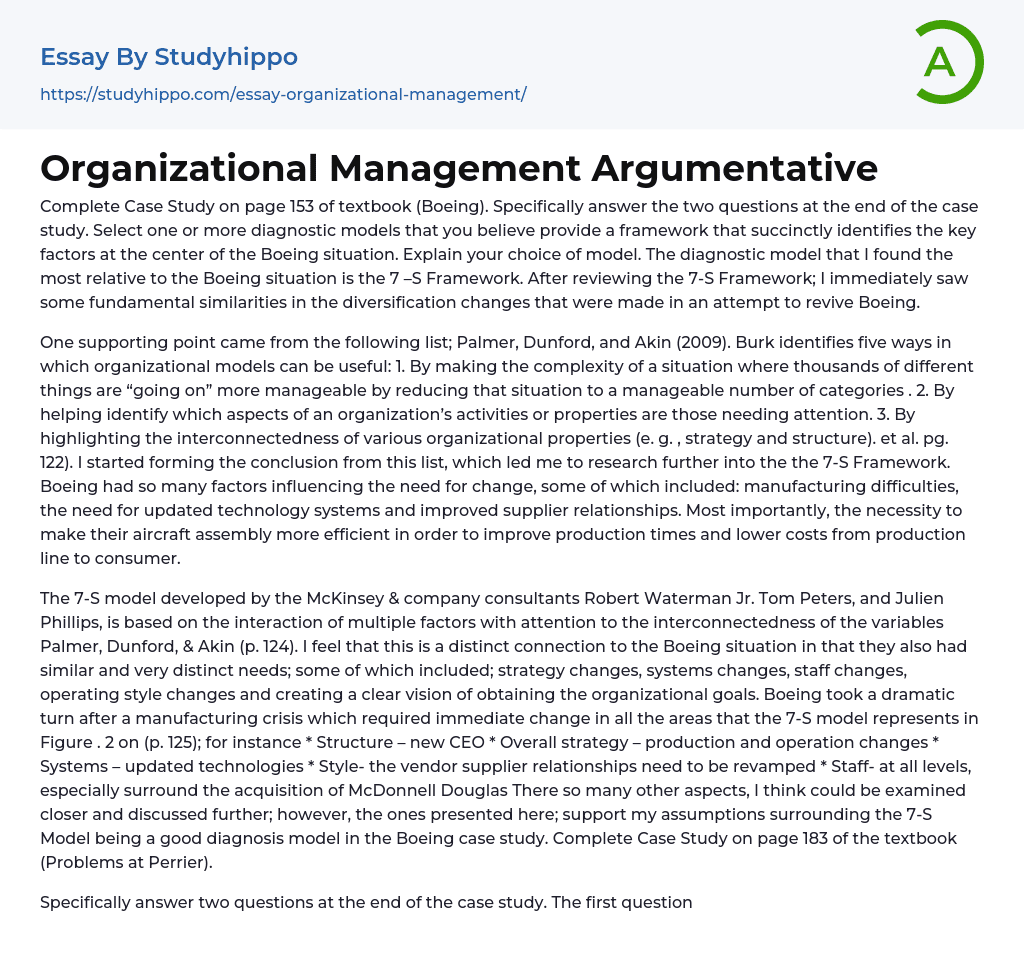Read the complete Case Study on page 153 of the textbook (Boeing) and provide answers to the two questions at the end. Choose one or more diagnostic models that you think effectively identify the main factors relevant to the Boeing situation and explain your selection of the model. The 7-S Framework is the diagnostic model that I found most applicable to the Boeing situation. Upon examining the 7-S Framework, I noticed significant similarities in the diversification changes implemented in an effort to revive Boeing.
The following list provided support from Palmer, Dunford, and Akin (2009) that identifies five ways in which organizational models can be useful. These include reducing complexity by categorizing situations, identifying areas needing attention, highlighting interconnectedness of organizational properties, and more (Burk et al., pg. 122). Based on this list, I be
...gan researching the 7-S Framework to draw my conclusion. Boeing faced numerous factors influencing the need for change, such as manufacturing difficulties and the need for updated technology systems and improved supplier relationships. The most crucial factor was the need to enhance aircraft assembly efficiency to improve production times and reduce costs from the production line to consumers.
The 7-S model, created by McKinsey & company consultants Robert Waterman Jr., Tom Peters, and Julien Phillips, emphasizes the interconnectedness of various factors in an organization (Palmer, Dunford, & Akin, p. 124). In relation to Boeing's situation, they had specific needs that align with the 7-S model, including strategy changes, systems changes, staff changes, operating style changes, and a clear vision of organizational goals. The manufacturing crisis at Boeing necessitated immediate changes in all areas represented in Figure .2 of the
7-S model (p. 125), such as a new CEO for structure, production and operation changes for overall strategy, updated technologies for systems, revamping vendor supplier relationships for style, and staffing changes surrounding the acquisition of McDonnell Douglas. Although there are other aspects that could be further examined and discussed, the presented elements support the effectiveness of the 7-S model as a diagnosis tool in Boeing's case study. The complete case study can be found on page 183 of the textbook (Problems at Perrier).
In this case study, the key elements of the resistance to change are discussed. The first question is about identifying these elements. According to Palmer, Dunford, and Akin (2009, pp. 162-167), there are several reasons why people resist change. Some of these include a dislike of change, discomfort with uncertainty, perceived negative effect on interests, and attachment to the established organizational culture/identity. I wanted to compare these reasons with the Perrier Case Study.
The quote by Nestle’s CEO Peter Brabeck-Letmathe, “We have come to the point where the development of the Perrier brand is endangered by the stubbornness of the CGT” (Palmer, et al…p. 182), serves as a strong illustration of the aversion to change. The relationship between Nestle's management and the workers at Perrier is characterized by communication problems. The majority of workers belonged to a union, CGT, and they consistently opposed any changes attempted by Nestle. It is evident that the workers' perception of negative consequences greatly contributed to their resistance towards change.
One instance of this is their concern about the 15% reduction in workforce and significant alterations to their social benefits, additional vacations, and potential
loss of other appealing employment aspects. Another crucial factor is their connection to the existing organizational culture and identity. Jean-Paul Franc, who leads CGT at Perrier, protests, "there are men and women who work here.... Morally speaking the water and gas stored below this ground belong to the whole region" (p. 183).
The management and workers at Perrier have a sense of cultural and historical ownership that makes them resistant to change. A change management strategy needs to be constructed to address this situation. It is important to identify and recommend approaches to managing resistance and provide a clear justification for the choices made. The strategy I would lean towards for change management at Perrier is as follows:
I. The reasons for the need for change should be clearly stated and identified. II. A detailed strategy should be communicated, including when and how the change will occur, as well as the positive goals and objectives that will result from the change. III. The organization should be communicated with as a whole, ensuring a sense of inclusion to lower resistance and increase acceptance. Provide a communication channel for questions, answers, and updates on progress. Table 2.1, which outlines "Six Methods for Managing Resistance to Change," references education, communication, and facilitation as top methods to include in a change management plan (Palmer, Dunford, and Akin, 2009).
- Board Of Directors essays
- Brand Management essays
- Business Ethics essays
- Business Management essays
- Change Management essays
- Comparative Analysis essays
- Decision Making essays
- Dispute Resolution essays
- Knowledge Management essays
- Leadership essays
- Leadership and Management essays
- Manager essays
- Operations Management essays
- Performance Management essays
- Product Management essays
- Project Management essays
- Quality Management essays
- Risk essays
- Risk Management essays
- Scientific Management essays
- Stress Management essays
- supply chain management essays
- Time Management essays
- Total Quality Management essays
- Collective Bargaining essays
- Corporate Culture essays
- Hard Work essays
- Job Satisfaction essays
- Organizational Culture essays
- Organizational Structure essays
- Sweatshops essays
- Workforce essays
- Working capital essays
- Working Class essays
- Working Time essays
- Workstation essays
- American Literature essays
- Between The World and Me essays
- Book Report essays
- Book Review essays
- Book Summary essays
- Books essays
- Character essays
- Coming of Age essays
- Dante's Inferno essays
- Everyday Use essays
- Flowers for Algernon essays
- Genre essays
- Greek Mythology essays
- Incidents in The Life of a Slave Girl essays




